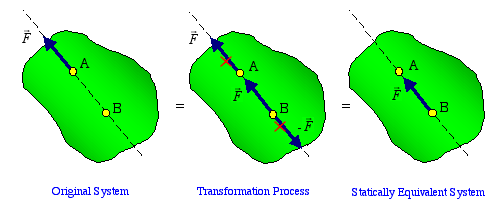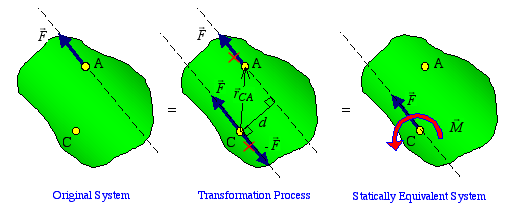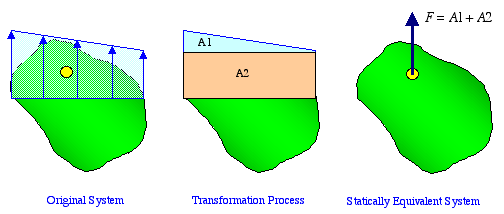Equivalent Systems
If a force acting on a body is represented (or replaced) by
another force or a force-moment system (at a different point on the
body) such that the resulting rigid-body effects (i.e., translation
and rotation) remain unchanged, the two systems are said to be
statically equivalent. We are interested
in this concept because in many statics problems, it may be more
convenient to replace the existing force with another equivalent
force or force-moment system.
Notice that although it is possible to keep the rigid-body
effects the same, it is impossible to keep the internal effects
such as stresses the same when we move the force from one location
to another. So the idea of equivalent systems is only to help with
the statics of a rigid body. We examine the topic of equivalent
systems by looking at three different cases as described below.
Case 1: Equivalent Force at an
Arbitrary Point Along the Same Line of Action: Let's
represent (replace) the force acting at point A by a statically
equivalent system at point B. In this case, point B is along the
line of action of the force at A. The statically equivalent system
is found by adding two equal and opposite forces at point B such
that each has the same magnitude as the original force and is
parallel to it as shown below. Since the two equal and opposite
forces shown at point B cancel each other, there is no net change
to the loading system in the transformation process. Canceling the
force Fat A with -Fat B gives the statically equivalent force at
B.

Case 2: Equivalent Force at an Arbitrary Point
Away from its Line of Action: Let's represent (replace) the
force acting at point A by a statically equivalent system at point
C. In this case, point C is not along the line of action of the
force at A. The statically equivalent system is found by adding two
equal and opposite forces at point C such that each has the same
magnitude as the original force and is parallel to it as shown
below. Although the force
Fat A added to
-
F at B results in a zero net force,
there remains a couple of magnitude
M =
Fd,which gives rise to a statically equivalent force-couple
system at C. Hence, when the force is moved to a point away from
its line of action, it will be accompanied by a couple
moment.

In vector form, the couple moment is found as

Since the magnitude of the couple moment is only a function of
the force magnitude and the perpendicular distance between the
force couple, it can be applied at any point on the body without
changing its effect. This is also the reason no subscript is shown
on the couple moment in this case.
Resultant of
Coplanar Forces: In calculating the force resultant, both force
and moment equivalency must be satisfied. In other words, the sum
of moments produced by individual forces about a point must be
equal to the moment produced by the resultant force.
A special case of a coplanar force system is that of parallel
forces commonly encountered in lateral loading of beams. What we
know about such systems is that the direction of the resultant
force is parallel to those of individual forces, but we may not
know its sense and location. This topic is explored further in the
following examples.
Example 1
Example 2
Example 3
Example 4
Case 3: Distributed Force Replaced by
an Equivalent Concentrated Force: In this case, a
distributed force is replaced by its resultant acting at the
centroid of the distributed area. The magnitude of the resultant
force is simply equal to the area of distribution. It is necessary
for the resultant force to be in the same direction as the
distributed force as shown below.

Key Observations:
We can slide a force to anywhere along its
line of action without changing its rigid-body effect. On the other
hand, if we move the force to a point away from its line of action,
then we must also include the accompanying moment. In either case,
we cannot change the magnitude or direction of the
force.
Test Your Knowledge


